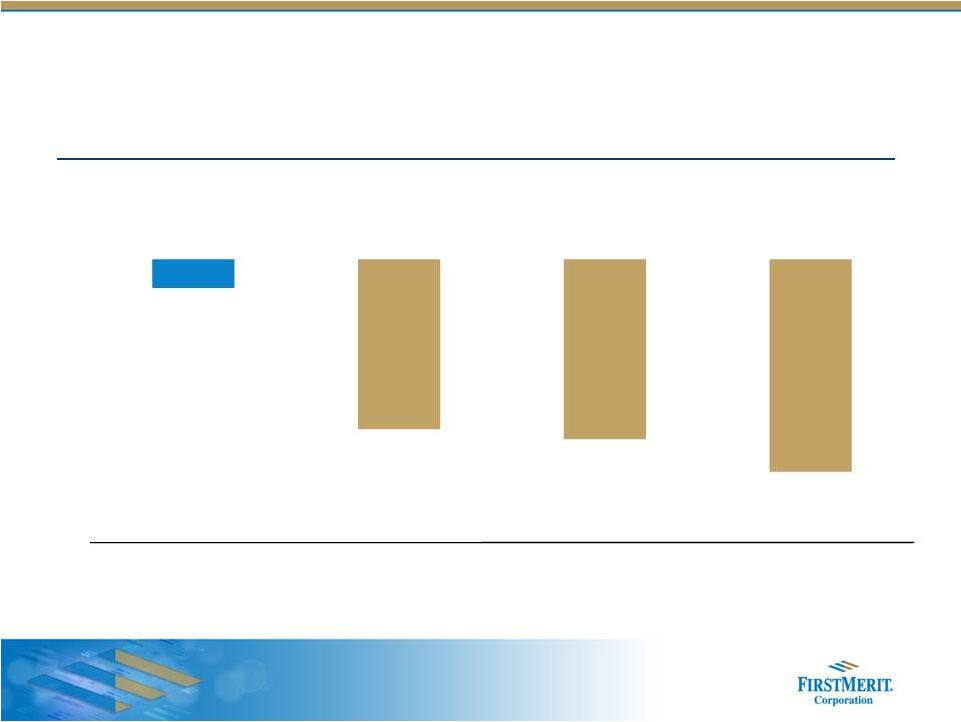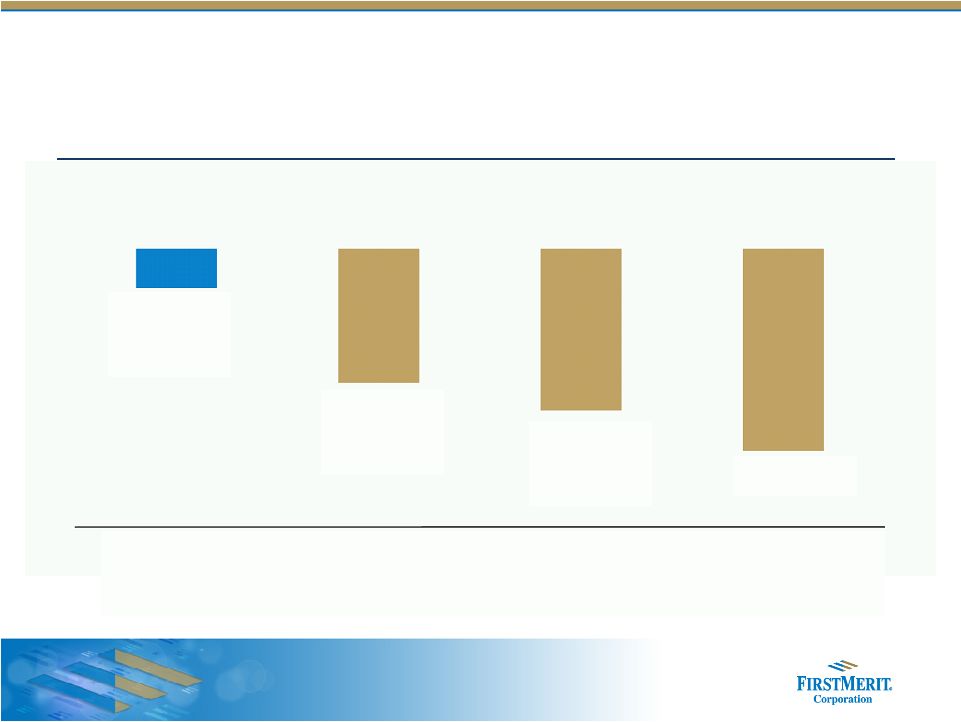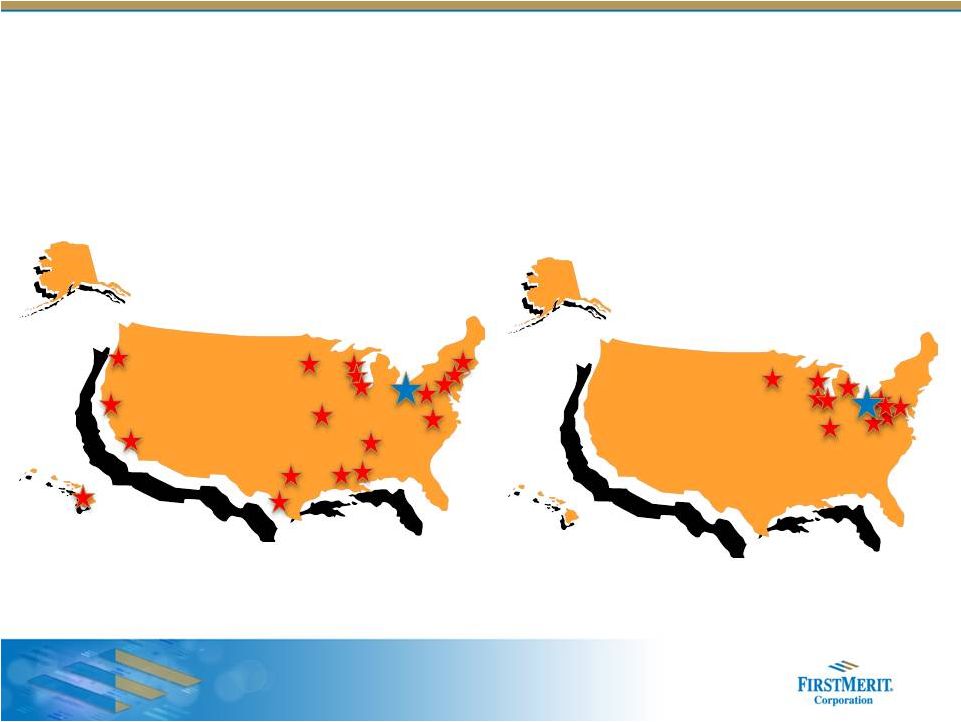Attached files
| file | filename |
|---|---|
| 8-K - 8-K - FIRSTMERIT CORP /OH/ | d326155d8k.htm |
 Management Say-on-Pay
Proposal Presentation
FirstMerit
Corporation
March 29, 2012
EXHIBIT 99.1 |
 This presentation contains forward-looking statements relating to present or
future trends or factors affecting the banking industry, and specifically
the financial condition and results of operations, including without
limitation, statements relating to the earnings outlook of FirstMerit Corporation (the
“Corporation”), as well as its operations, markets and products. Actual
results could differ materially from
those
indicated.
Without
limiting
the
foregoing,
the
word
“believes”
and
similar
expressions
are
intended to identify forward-looking statements. Among the important factors
that could cause results to differ materially are interest rate changes,
continued softening in the economy, which could
materially
impact
credit
quality
trends
and
the
ability
to
generate
loans,
changes
in
the
mix
of
the
Corporation’s
business,
competitive
pressures,
changes
in
accounting,
tax
or
regulatory
practices
or
requirements
and
those
risk
factors
detailed
in
the
Corporation's
periodic
reports
and
registration statements filed with the Securities and Exchange Commission. The
Corporation undertakes no obligation to release revisions to these
forward-looking statements or reflect events or circumstances after the
date of this release. Forward-Looking
Statement
Disclosure
2 |
 This presentation was prepared by the Corporation on behalf of its Board of
Directors (the “Board”) for use by those employees of the
Corporation authorized to communicate with shareholders of the Corporation
pursuant to its internal policies. The members of the Board may have an interest in the
Corporation’s proposals regarding director elections and the approval of named
executive officer compensation (“Say-on-Pay Proposal”) to
be presented at the 2012 Annual Meeting of Shareholders (“2012 Annual
Meeting”). The Corporation’s security holders should read the Corporation’s 2012
definitive proxy statement for its 2012 Annual Meeting because it contains
important information. Security holders may obtain the
Corporation’s 2012 definitive proxy statement and 2011 Annual Report
for
free
at
www.firstmerit.com.
This
document
may
be
deemed
“soliciting
material”
within
the
meaning
of
the rules and regulations of the Securities and Exchange Commission promulgated
under the Securities Exchange Act of 1934, as amended.
Explanatory Note
3 |
 Management Say-on-Pay Proposal
4
•
Say-on-pay analysis by certain proxy advisors seems to reach the wrong
conclusion on vote recommendation
because
it
fails
to
take
into
account
performance
criteria
that
are
specific
to
our
industry, our organization structure, and our business strategy in
particular. Most importantly, the analysis:
•
As described in great detail in our proxy statement we believe we operated a fair
and effective compensation
program
in
2011
that
helped
us
motivate,
reward
and
retain
executive
talent
with
the
skills
and experience necessary to achieve our business goals and create long-term
shareholder value Overemphasized short-term (1 & 3-year)
relative total shareholder return (“RTSR”) results in
a
volatile
economic
climate
while
ignoring
our
strong
RTSR
results
versus
peers
over
the long-term (5 & 10-year), as described in the proxy statement
Did not recognize and appreciate the performance-based structure and operation
of our short-term
incentive
compensation
plan,
specifically
redesigned
for
2011
to
enable
our
Compensation Committee to make sound compensation decisions reflecting internal
goals and considering relative peer performance given an uncertain/changing
economic and regulatory climate, while not encouraging excessive
risk-taking Judged our CEO pay decisions against a group that includes
companies not within our geographic proximity and with whom we do not
compete with for executive talent Failed
to
appreciate
our
strong
performance
in
2011
with
respect
to
the
key
quantitative
and qualitative performance metrics that we believe drive shareholder value
creation in our business over time, and the critical role our CEO played in
achieving these results |
 Strength of Underlying Corporate Performance
5
•
51 consecutive quarters of profitability as of fourth quarter, 2011
•
Full year 2011 net income of $120 mm, up 16% from 2010
$1.10 per diluted share
Return on total average assets of 0.82%
Return
on
average
shareholders’
equity
of
7.72%
•
2011 total commercial loan production increased 38% over 2010
14% increase in average commercial* loans from 4Q10 to 4Q11
$394 mm in commercial loans originated in Illinois
•
Solid asset quality trends
Net charge-offs/Average loans at 0.85%, compared with 1.23% in 2010
Nonperforming
assets/Total
loans
and
ORE
at
1.06%,
compared
with
1.78%
in
2010
•
84% of deposits are “Core”
14% increase in average core deposits from 4Q10 to 4Q11
*excluding covered loans |
 6
•
The
proxy
advisors’
methodology
disregards
the
relative
strength
of
our
stock
price
at
the
beginning
of
the
3-year
RTSR
measurement
period.
More
importantly,
the
methodology
ignores
our
continued
superior performance against key corporate metrics that are unique to the banking
industry, which was achieved notwithstanding the fee reductions resulting
from the Durbin amendment •
The pre-dominant emphasis on RTSR in the methodology may have lead the advisors
to the wrong conclusion since:
It did not take into account the short-term fluctuations and arbitrary nature
of the financial markets, which have been especially volatile with all bank
stocks in recent years Using RTSR as the sole metric for assessing Board
compensation decisions (a metric not totally controllable by management) on
the level of pay to the CEO fails to reflect the real value the Board
believes the CEO provides in executing our business strategy •
We believe the design of our compensation program is sound and that it
appropriately rewards our executives for achieving Board-approved
strategic objectives, as described in the proxy Short-Term RTSR vs.
Underlying Corporate Performance |
 History of Superior
Performance Continued in 2011….. 2011
FirstMerit
Peers
7.72%
5.07%
0.82%
0.60%
0.85%
1.83%
1.06%
2.68%
3.84%
3.81%
2010
FirstMerit
Peers
Return on average
shareholders’
equity
7.82%
1.66%
Return on total
average assets
0.76%
0.17%
Net charge-offs/
Average loans
1.23%
2.26%
Nonperforming assets/
Total loans and ORE
1.78%
3.05%
Net interest margin
3.98%
3.76%
7
Critical Financial Performance Metrics Relative to Peer Averages
Source:
SNL
Financial
Peer
Group
Includes:
Associated
Banc-Corp,
Citizens
Republic,
Bancorp,
F.N.B.
Corporation,
First
Commonwealth,
First
Midwest
Bancorp,
Fulton
Financial,
MB Financial, Old National Bancorp, Park National Bancorp, Susquehanna Bancshares, TCF Financial
|
 2009
FirstMerit
Peers
8.09%
-1.78%
0.76%
-0.25%
1.22%
1.88%
1.48%
2.76%
3.58%
3.56%
2008
FirstMerit
Peers
Return on average
shareholders’
equity
12.76%
2.53%
Return on total
average assets
1.13%
0.19%
Net charge-offs/
Average loans
0.68%
0.83%
Nonperforming assets/
Total loans and ORE
0.77%
1.68%
Net interest margin
3.72%
3.65%
8
Critical Financial Performance Metrics Relative to Peer Averages
Source:
SNL Financial
Peer
Group
Includes:
Associated
Banc-Corp,
Citizens
Republic,
Bancorp,
F.N.B.
Corporation,
First
Commonwealth,
First
Midwest
Bancorp,
Fulton
Financial,
MB Financial, Old National Bancorp, Park National Bancorp, Susquehanna Bancshares, TCF Financial
…..Following Historical Trends |
 9
Source:
Bloomberg Financial
Peer
Group
Includes:
Associated
Banc-Corp,
Citizens
Republic,
Bancorp,
F.N.B.
Corporation,
First
Commonwealth,
First
Midwest
Bancorp,
Fulton
Financial,
MB Financial, Old National Bancorp, Park National Bancorp, Susquehanna Bancshares,
TCF Financial FMER
Peers
KBW Bank Index
S&P Diversified Financials
-8.1%
-48.1%
-50.9%
-60.0%
Superior Relative Stock Performance Throughout Financial Crisis
Four-Year Total Shareholder Return 12/31/07-12/30/11
|
 10
Superior Relative Stock Performance Over Longer Term
Source:
Bloomberg Financial
Peer
Group
Includes:
Associated
Banc-Corp,
Citizens
Republic,
Bancorp,
F.N.B.
Corporation,
First
Commonwealth,
First
Midwest
Bancorp,
Fulton
Financial,
MB Financial, Old National Bancorp, Park National Bancorp, Susquehanna Bancshares,
TCF Financial Ten Year Total Shareholder Return
12/31/01-12/30/11 -11.3%
-38.6%
-
46.5%
-58.1%
FMER
KBW Bank Index
S&P Diversified Financials
Peers |
 Successful Execution of Strategic Initiatives
11
•
Successful
Execution
of
Chicago
Strategy
—
We
successfully
increased
our
growth
and
footprint
in
greater Chicago:
Increasing our Chicago-area commercial loan production by over 120% from
2010 Significant increases in our greater Chicago non-covered loan
portfolio Fully staffing our Illinois indirect lending office and signing up
130 Chicago-area dealers for indirect lending
•
Growth
in
Market
Share
—
We
continued
to
develop
and
execute
on
initiatives
to
grow
our
market
share for various products:
Launching marketing campaigns regarding our home equity line of credit, credit
card, mortgage and checking products
Conducting quarterly cross sell campaigns to target single service and next best
product offers
Raising brand awareness through various targeted promotional activities in key
geographic areas |
 Successful Execution of Strategic Initiatives (cont’d.)
12
Increasing our customers’
use of electronic banking statements
Developing a comprehensive e-mail and online marketing strategy
Increasing our offering of mobile banking applications
•
New
Product
Build
Out
—
We
successfully
designed,
launched
and
executed
a
slate
of
redefined
products:
Consumer deposit products
Private banking products
Commercial banking products
•
Dynamic
Market
Response
the wake of the recent financial crisis:
—
We
continued
to
enhance
our
ability
to
react
to
market
changes
in |
 Peer Group Disparity
13
FirstMerit Peer Group:
Proxy Advisory Firm Peer Group:
•
•
Developed with the assistance of our independent compensation consultant to
benchmark CEO compensation
Consists of 11 regional banking institutions carefully selected to (1) include
companies against which we compete for executive talent, based on asset
size, and (2) take into account our geographic market since we face similar
economic trends with companies in that market Consists
of
24
institutions
developed
based
on
a
“one-size
fits
all”
model
using
asset
size
and
then within Global Industry Compliance Services code
Is
not
a
peer
group
that
is
comprised
of
companies
with
which
we
compete
for
executive
talent
We do not compete with regional banks in Hawaii, Oregon, California, Texas,
Louisiana, Mississippi, Connecticut, or New Jersey (which are in the
advisor’s peer group) End
result
is
a
peer
group
containing
many
institutions
that
are
not
suitable
for
comparison
with FirstMerit for making performance and pay decisions
|
 Peer Group Disparity (cont’d.)
14
Proxy Advisory Peer Group
FirstMerit Peer Group
•
Generally far from Akron, OH
•
We don’t recruit talent from
all over the United States
•
Near Akron, OH
•
Represents the region from
which we draw talent
vs. |
 2011 Short-Term Incentive Compensation Program
15
•
As described in detail in our proxy, we re-designed our annual incentive
compensation program (ICP) in 2011 to more effectively align pay and
performance, while retrospectively taking into account the effect of
unsettled financial services markets, general volatility and low interest rates in
the economy, and unexpected regulatory changes in our industry
The ICP is first based upon a combination of 1) specific corporate objectives and
assessment criteria, 2) performance relative to bank company peers, and 3)
individual performance criteria evaluated over the course of the fiscal
year Second,
final
ICP
determinations
are
made
by
the
Board
Committee
using
structured
(defined
assessment criteria) discretion to take into account unanticipated factors
that occurred during the course of the year, either positively or
negatively Third, the ICP approach provides for a formula-based
design within structured discretion that is
considered
a
“best
practice”
from
a
bank
regulatory
perspective
•
We believe that our proxy provides significant detail on the criteria the Committee
used in deciding on our CEO’s pay for 2011
Goal of the new incentive approach is to balance management’s focus between
annual performance and long-term performance with incentive
programs |
 2011 Long-Term Equity Based Grants
16
•
Our equity based program is focused on providing a direct line of sight for
participants to the link between their performance and pay and the
long-term success of our company, while balancing the expectations
of
multiple
constituencies
--
shareholders,
bank
regulators
and
compensation
requirements in our industry
Banks in our peer group grant a majority of their equity in the form of
full-value shares. We are
consistent
with
our
peer
group
by
granting
restricted
stock,
which
for
FirstMerit
vests
over
three years
The total shares granted annually to the participant group is based upon corporate
performance
using
structured
discretion
which
takes
into
account
financial
measures
that
are
consistent with shareholder value. These factors are evaluated against
internal and external criteria before a final Committee decision
Granting
restricted
stock
annually
helps
our
executives
meet
our
stock
ownership
guidelines
and directly aligns their interests with those of shareholders in preserving and
enhancing shareholder value (On a long-term basis, our CEO is required
to hold five times his base salary in the form of stock and our non-CEO
Section 16 officers are required to hold two and one half times their base
salary) |
 •
Proxy advisor analysis of CEO pay compared to peers did not account for all
factors •
The proxy advisors’
methodology for evaluating the reasonableness of CEO pay compared to peers
seems to reach the wrong conclusion when considering the unique circumstances of
our CEO when accounting for and reporting the annual accrual value of his
retirement income •
30% of our CEO’s total compensation for 2011 consistent of an accrual for
retirement benefits which will not be realized for several years
•
Deducting unrealized retirement accrual amounts from both our CEO’s total
compensation and from the compensation of the proxy advisor’s CEO peer
group provides a different perspective Our CEO’s total direct
compensation falls to approximately 1.58 times the mean of CEO pay for the
proxy advisor’s peer group and 2.19 times the mean of CEO pay of the FMER peer
group
Five of the 11 FMER peer institutions held TARP funds in 2011 which restricts
compensation (3 of the peer institutions held TARP at year-end)
Impact of Year-over-Year Change in Compensation Value
17 |
 Important Facts about Excise Tax Gross-Up
18
•
Proxy advisory firms expressed concerns that 280G gross-up provisions could
result in substantial increases in termination payments to executives or
could encourage executives to enter into corporate transactions that are not
in a company’s best interests •
These
concerns,
although
reasonable,
will
not
come
into
play
for
our
executives
since:
The
CEO
is
the
only
executive
entitled
to
a
280G
gross-up
–
all
other
executives
are
subject
to a 280G cut-back
Changes in the contracts with three other executives would have resulted in saving
the Corporation nearly $2 million based on a potential December 30, 2011
change in control and termination
The CEO cannot unilaterally enter into a change in control discussion without
Board approval –
his
change
in
control
agreement
provides
that
if
he
does
so,
he
will
not
be
entitled
to
any
payments under the agreement |
 •
Proxy advisors have not taken into account the following facts regarding our
succession planning: Our current organization structure does NOT include a
Chief Operating Officer by design and thus creates a high compensation
ratio to other named executives, even though the policy level of pay for
other named executives is consistent with market rates for similar positions
Management meets semi-annually to assess high-level potential talent and
the progress of its development plans and provides an annual report of its
findings to the Board, including internal talent for the CEO position
The Corporation has a recent history of promoting existing FirstMerit employees to
key executive roles
Robust Succession Planning Process in Place
19 |
 Contacts for Discussion
20
•
Tom O’Malley –
SVP, Director of Investor Relations & Corporate Communication
•
Judy Steiner –
Executive Vice President, Risk Management, Corporate Secretary and General
Counsel |
